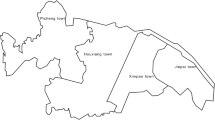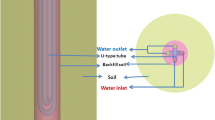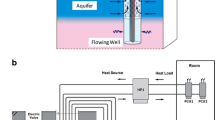Abstract
The U-type ground heat exchanger is a significant component of the ground source heat pump (GSHP) system, transferring heat from the soil for the air conditioning requirements. Heat accumulation becomes a common problem for the practical application of such systems in southern China. Moreover, the buried pipes containing heat exchangers are constructed in a group form, making the heat accumulation situation more severe and complex. A 3-dimensional simulation model of a 9-well buried pipe group was established and validated by a thermal response test conducted in Nanjing, China. On the basis of this model, the influence of underground seepage water temperature and flow rate on thermal distribution was investigated. Subsequently, the heat transfer capacity of single-well depth in a heat exchanger under varying conditions was calculated. It is concluded that a serious heat accumulation occurs without groundwater seepage. With seepage flow, the heat accumulation can be dissipated. Lower seepage temperature has a modestly beneficial effect on the heat dissipation. The heat accumulation can be better dissipated and the heat transfer capacity per well depth can be improved with greater seepage flow rate.
Similar content being viewed by others
References
ANSYS I (2015a). Theory Guide (release 16.0). Basic Fluid Flow.
ANSYS I (2015b). User’s Guide (release 16.0). Cell Zone and Boundary Conditions.
Bayer P, de Paly M, Beck M (2014). Strategic optimization of borehole heat exchanger field for seasonal geothermal heating and cooling. Applied Energy, 136: 445–453.
Bouhacina B, Saim R, Oztop HF (2015). Numerical investigation of a novel tube design for the geothermal borehole heat exchanger. Applied Thermal Engineering, 79: 153–162.
Brunetti G, Saito H, Saito T, Šimůnek J (2017). A computationally efficient pseudo-3D model for the numerical analysis of borehole heat exchangers. Applied Energy, 208: 1113–1127.
Cui Y, Zhu J (2018). CFD assessment of multiple energy piles for ground source heat pump in heating mode. Applied Thermal Engineering, 139: 99–112.
Fang H, Xia J, Lu A, Jiang Y (2014). An operation strategy for using a ground heat exchanger system for industrial waste heat storage and extraction. Building Simulation, 7: 197–204.
Fasquelle A, Pellé J, Harmand S, Shevchuk IV (2014). Numerical study of convective heat transfer enhancement in a pipe rotating around a parallel axis. Journal of Heat Transfer, 136(5): 051901.
Gan G (2018). Dynamic thermal performance of horizontal ground source heat pumps—The impact of coupled heat and moisture transfer. Energy, 152: 877–887.
Geng S, Li Y, Han X, Lian H, Zhang H (2016). Evaluation of thermal anomalies in multi-boreholes field considering the effects of groundwater flow. Sustainability, 8(6): 577.
Gong X, Xia L, Ma Z, Chen G, Wei L (2018). Investigation on the optimal cooling tower input capacity of a cooling tower assisted ground source heat pump system. Energy and Buildings, 174: 239–253.
Hua J, Li G, Zhao X, Wu W, Li D, Li Q (2017). The hot stack performance of the shallow geothermal heat pump system with/without intensification state of groundwater seepage in Nanjing (China). Energy and Buildings, 150: 558–566.
Huang S, Ma Z, Wang F (2015). A multi-objective design optimization strategy for vertical ground heat exchangers. Energy and Buildings, 87: 233–242.
Koohi-Fayegh S, Rosen MA (2012). Examination of thermal interaction of multiple vertical ground heat exchangers. Applied Energy, 97: 962–969.
Lee JY (2009). Current status of ground source heat pumps in Korea. Renewable and Sustainable Energy Reviews, 13: 1560–1568.
Li M, Lai ACK (2013). Thermodynamic optimization of ground heat exchangers with single U-tube by entropy generation minimization method. Energy Conversion and Management, 65: 133–139.
Li C, Cleall PJ, Mao J, Moñoz-Criollo JJ (2018). Numerical simulation of ground source heat pump systems considering unsaturated soil properties and groundwater flow. Applied Thermal Engineering, 139: 307–316.
Liu Z, Xu W, Qian C, Chen X, Jin G (2015). Investigation on the feasibility and performance of ground source heat pump (GSHP) in three cities in cold climate zone, China. Renewable Energy, 84: 89–96.
Liu J, Xie X, Qin F, Song S, Lv D (2016). A case study of ground source direct cooling system integrated with water storage tank system. Building Simulation, 9: 659–668.
Luo J, Rohn J, Xiang W, Bertermann D, Blum P (2016). A review of ground investigations for ground source heat pump (GSHP) systems. Energy and Buildings, 117: 160–175.
Makasis N, Narsilio GA, Bidarmaghz A, Johnston IW (2018). Groundsource heat pump systems: The effect of variable pipe separation in ground heat exchangers. Computers and Geotechnics, 100: 97–109.
Man Y, Yang H, Wang J (2010). Study on hybrid ground-coupled heat pump system for air-conditioning in hot-weather areas like Hong Kong. Applied Energy, 87: 2826–2833.
Naili N, Hazami M, Attar I, Farhat A (2013). In-field performance analysis of ground source cooling system with horizontal ground heat exchanger in Tunisia. Energy, 61: 319–331.
Ni L, Li H, Jiang Y, Yao Y, Ma Z (2011). A model of groundwater seepage and heat transfer for single-well ground source heat pump systems. Applied Thermal Engineering, 31: 2622–2630.
Noorollahi Y, Saeidi R, Mohammadi M, Amiri A, Hosseinzadeh M (2017). The effects of ground heat exchanger parameters changes on geothermal heat pump performance—A review. Applied Thermal Engineering, 129: 1645–1658.
Shang Y, Li S, Li H (2011). Analysis of geo-temperature recovery under intermittent operation of ground-source heat pump. Energy and Buildings, 43: 935–943.
Wang X, Wang Y, Wang Z, Liu Y, Zhu Y, Chen H (2018). Simulationbased analysis of a ground source heat pump system using super-long flexible heat pipes coupled borehole heat exchanger during heating season. Energy Conversion and Management, 164: 132–143.
Wei K, Li W, Li J, Wang Y, Zhang L (2017). Study on a design method for hybrid ground heat exchangers of ground-coupled heat pump system. International Journal of Refrigeration, 76: 394–405.
Wu W, Skye HM (2018). Progress in ground-source heat pumps using natural refrigerants. International Journal of Refrigeration, 92: 70–85.
Xi J, Li Y, Liu M, Wang R (2017). Study on the thermal effect of the ground heat exchanger of GSHP in the eastern China area. Energy, 141: 56–65.
Xia L, Ma Z, Mclauchlan C, Wang S (2017). Experimental investigation and control optimization of a ground source heat pump system. Applied Thermal Engineering, 127: 70–80.
You T, Wu W, Shi W, Wang B, Li X (2016). An overview of the problems and solutions of soil thermal imbalance of groundcoupled heat pumps in cold regions. Applied Energy, 177: 515–536.
You T, Shi W, Wang B, Wang H, Li X (2017). A fast distributed parameter model of ground heat exchanger based on response factor. Building Simulation, 10: 183–192.
Zhang W, Yang H, Fang L, Cui P, Fang Z (2017). Study on heat transfer of pile foundation ground heat exchanger with threedimensional groundwater seepage. International Journal of Heat and Mass Transfer, 105: 58–66.
Zhang W, Yang H, Guo X, Yu M, Fang Z (2016). Investigation on groundwater velocity based on the finite line heat source seepage model. International Journal of Heat and Mass Transfer, 99: 391–401.
Zhou S, Cui W, Li Z, Liu X (2016). Feasibility study on two schemes for alleviating the underground heat accumulation of the ground source heat pump. Sustainable Cities and Society, 24: 1–9.
Acknowledgements
This work is supported by the National Natural Science Foundation of China (No. 51806096) and Natural Science Foundation of the Jiangsu Higher Education Institutions of China (No. 18KJB560007).
Author information
Authors and Affiliations
Corresponding author
Rights and permissions
About this article
Cite this article
Wang, Y., Liu, Z., Yuan, X. et al. Investigation of the influence of groundwater seepage on the heat transfer characteristics of a ground source heat pump system with a 9-well group. Build. Simul. 12, 857–868 (2019). https://doi.org/10.1007/s12273-019-0526-4
Received:
Revised:
Accepted:
Published:
Issue Date:
DOI: https://doi.org/10.1007/s12273-019-0526-4




